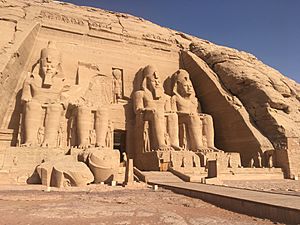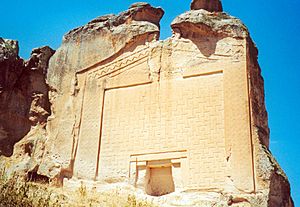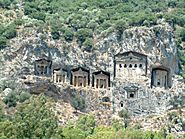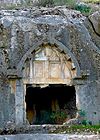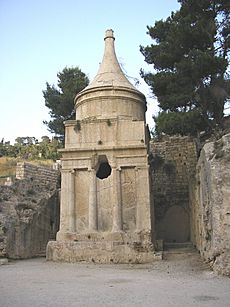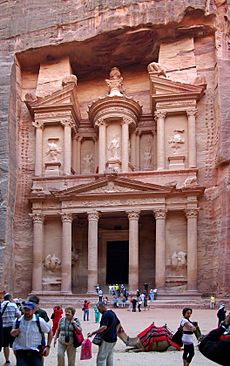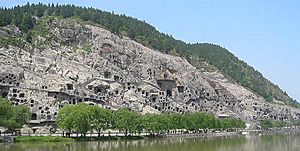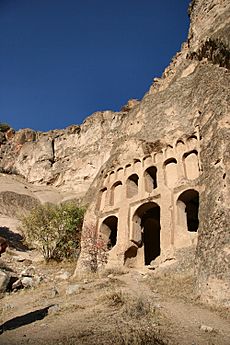Rock-cut architecture facts for kids
Rock-cut architecture is a special way of building. It means creating structures, buildings, or sculptures by carving them directly out of solid rock. Imagine a mountain or a cliff, and then people carving out rooms, temples, or even whole buildings inside it!
This type of architecture is completely man-made from start to finish. In places like India and China, these carved structures are often called 'caves' or 'caverns'. However, natural caves that people just changed a little bit are not considered rock-cut architecture.
Even though rock-cut buildings are different from regular buildings, many of them look like traditional structures. They might have similar fronts or inside designs. Workers usually started carving from the roof of the planned space and then worked their way down. This was a smart way to prevent rocks from falling on them.
Rock-cut architecture was mainly used for three things:
- Temples: Like the amazing ones in India.
- Tombs: Such as those found in Petra, Jordan.
- Cave homes: Like the unique dwellings in Cappadocia, Turkey.
Some rock-cut buildings, especially tombs, are completely hidden underground. Others are carved into the side of a cliff. These often have impressive fronts, like those in Lycia, Petra, and Ajanta.
The most difficult and amazing rock-cut buildings are huge, free-standing structures. They are carved entirely below the ground level, with a large hole dug around them. The Ellora Caves in India and the churches of Lalibela in Ethiopia are famous examples of these incredible structures.
Creating rock-cut architecture was very hard work, especially with old tools. But it was often combined with quarrying, which means digging out rocks for other uses. The huge amounts of stone removed usually disappeared, used for other projects.
Sometimes, you'll hear the term monolithic architecture. This refers to structures made from a single piece of material. Many rock-cut buildings are monolithic, like the Kailasa Temple at Ellora. But monolithic structures can also be made from artificial materials like concrete. The Gommateshwara statue in India, built in 983 AD, is the world's largest monolithic statue. It was carved from one huge block of granite.
Contents
History of Rock-Cut Buildings
Ancient rock-cut buildings are found all over the world. People started changing natural caves in the Stone Age on islands like Malta and Sardinia. These changes happened between 3,000 and 1,500 BCE.
Ancient Egypt's Grand Carvings
Large rock-cut structures were built in Ancient Egypt. One of the most famous is the Great Temple of Ramesses II, also known as Abu Simbel. It's located along the Nile River in Nubia, near Sudan. This temple dates back to about 1280 BCE. It has a huge front carved out of the cliff and many rooms inside that form its sacred area.
Early Examples in Turkey
Around the 8th century BCE, the Phrygians in what is now Turkey started building rock-cut monuments. The Midas Monument (700 BCE) is one of the earliest. It was dedicated to the famous Phrygian king Midas.
Later, in the 5th century BCE, the Lycians in southern Turkey built hundreds of similar rock-cut tombs. These were smaller. Great examples can be seen near Dalyan, carved into the cliffs facing a river. Since these were tombs, their insides were usually small and simple.
The ancient Etruscans in central Italy also created many rock-cut tombs. You can find these near the cities of Tarquinia and Vulci.
In ancient Israel, people started making rock-cut tombs around the 8th century BCE. This continued through the Byzantine period. The Tomb of Absalom, built in the 1st century AD, is in the Kidron Valley of Jerusalem.
India's Rock-Cut Wonders
Rock-cut architecture is very important in the history of Indian architecture. The earliest examples, the Barabar Caves, date from about 250 to 150 BCE. Buddhist monks built these. They carved multi-story buildings into mountain faces. These buildings had living areas, sleeping quarters, kitchens, and spaces for monks. Some even had shrines to Buddha and saints.
Over time, the insides of these caves became more detailed. Surfaces were often decorated with paintings, like those at Ajanta Caves. In the early 7th century, Hindu rock-cut temples began to appear at Ellora. Unlike earlier examples, these were complete 3D buildings carved out of the hillside. They took many generations to plan and finish. Other major rock-cut sites in India include Ajanta and Pataleshwar.
Petra's Famous Treasury
The Nabataeans, in their city of Petra in Jordan, continued the tradition of carving into rock. They carved their temples and tombs into the yellowish-orange rock of the canyons. These structures, built from the 1st century BCE to the 2nd century CE, are important because of their unique shapes. Since they were mostly tombs, their insides were quite plain. In Petra, you can even find a theater where the seats are carved out of the rock!
Rock-Cut Sites in China and Turkey
The skills for making these complex structures traveled to China along trade routes. The Longmen Grottoes, Mogao Caves, and Yungang Grottoes have hundreds of caves. Many of them contain statues of Buddha. Most were built between 460 and 525 AD.
There are also many rock-cut buildings, including houses and churches, in Cappadocia, Turkey. They were built over hundreds of years before the 5th century CE. Here, the focus was more on the inside of the buildings than the outside.
Another large site of rock-cut architecture is Lalibela, a town in northern Ethiopia. This area has many Orthodox churches that are carved out of the rock, just like at Ellora. These structures, from the 12th and 13th centuries CE, are some of the most amazing examples of rock-cut architecture in the world. Both their insides and outsides are beautifully finished.
Art in Rock-Cut Architecture
Ancient rock-cut tombs, temples, and monasteries were often decorated with paintings called frescoes and carved reliefs. The strong natural rock, skilled use of plaster, and steady climate inside often helped to keep this art in better condition than art in regular buildings.
Amazing examples include:
- The ancient frescoes in the Bamyan Caves in Afghanistan. These have the oldest known oil paintings in the world, from the 8th century AD.
- The Ajanta Caves in India, with well-preserved tempera paintings from the 2nd century BCE.
- Christian frescoes in the Churches of Göreme, Turkey.
- Many other monuments across Asia, Europe, and Africa.
Timeline of Rock-Cut Architecture
Here's a quick look at when some famous rock-cut sites were built:
- 1450 BCE: Egyptian rock-cut tombs in Thebes, Egypt.
- 1250 BCE: Hittite rock-cut sanctuaries.
- 700 BCE: Phrygian rock-cut tombs, like the Midas monument.
- 500 BCE: Etruscan rock-cut tombs in Etruria, Italy.
- 480 BCE: Tomb of Darius I at Naqsh-e Rostam.
- 4th century BCE: Lycian rock-cut tombs.
- 250 BCE: Barabar Caves, India.
- 100 BCE: Buddhist caves in Western Ghats, India.
- 100 CE: Petra, Jordan.
- 100 CE: Buddhist caves in Northwestern India.
- 100 CE: Houses in Tiermes, Spain.
- 400 CE: Buddhist caves in Dunhuang, China.
- 480 CE: Buddhist caves at Ajanta, India.
- 600 CE: Hindu temple at Elephanta, India.
- 650-750 CE: Hindu temples in Southern India.
- 700-900 CE: Hindu, Buddhist, and Jain caves at Ellora, India.
- 900 CE: Churches in Cappadocia, Turkey.
- 1000 CE: Churches in Lalibela, Ethiopia.
Images for kids
See also
 In Spanish: Arquitectura rupestre para niños
In Spanish: Arquitectura rupestre para niños


